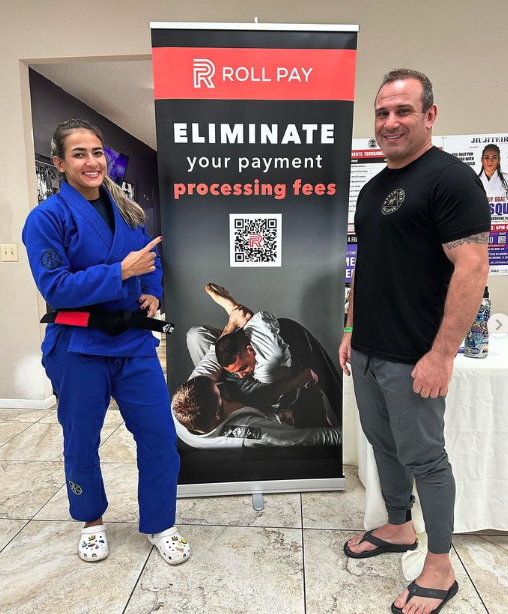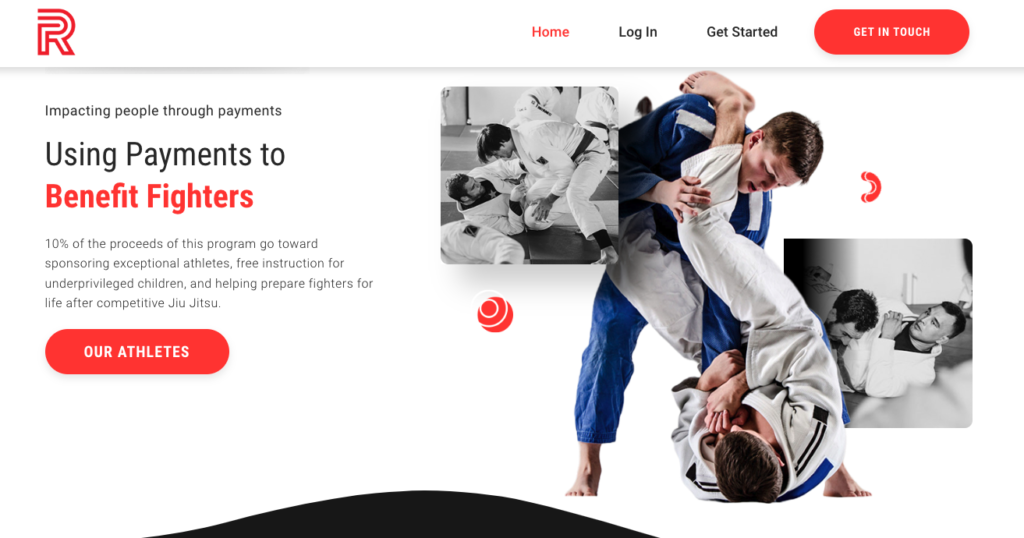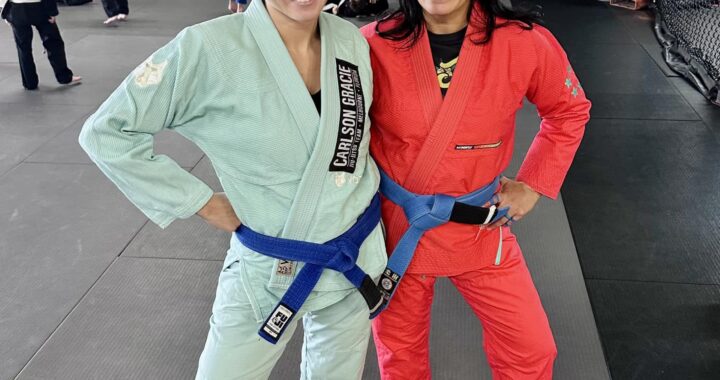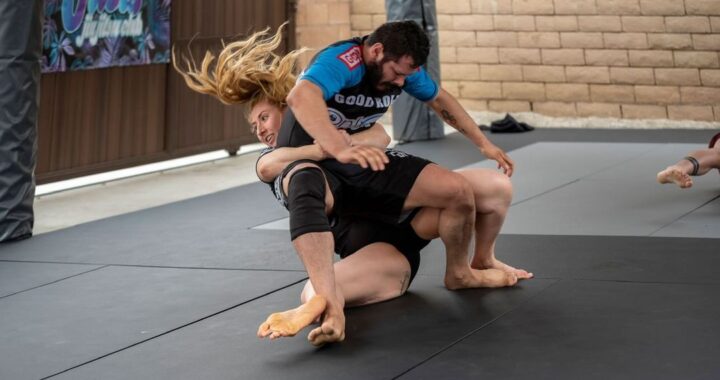Revolutionizing Gym Finances: How RollPay Helps Gym Owners Save and Give Back to the Jiu-Jitsu Community

RollPay is dedicated to reducing operational expenses for gyms, empowering athletes, and advancing the sport of Brazilian Jiu-Jitsu
Interview by Evelyn Sutton
Story and edit by Charlotte McKinley
What could gym owners do if they could save money on processing payments? Expand mat space, buy new mats and equipment, upgrade their facilities — the list goes on. Finding ways to save is difficult, however. That’s where RollPay comes in.
Started in at Checkmat Murrieta, in California, Eric Shasha set out to help his coach deal with payment processing easier. When they tested the system and it was successful, word of mouth quickly led to the creation of RollPay. Now, each month, about 20 gyms make the switch to the payment processing company.
But how does RollPay save gyms money? By having the customer cover the processing fee.
Often, most gyms use bigger software that they do not need and do not utilize to its full potential thereby costing them in the long run. RollPay comes alongside these gyms and simplifies matters all while saving gyms hundreds, if not thousands, of dollars monthly.
In addition to helping gyms mitigate costs when it comes to payment processing fees, RollPay gives back to the Jiu-Jitsu community by not only sponsoring Jiu-Jitsu athletes, but also training them in how to sell merchant services which not only allows them flexibility in their schedule to train but allows for them to have a retirement plan.
Additionally, 10% of RollPay’s revenue goes toward sponsorship of athletes but also Jiu-Jitsu instruction for underprivileged children.
JM: Tell me about your history, participation in the Jiu-Jitsu community and how RollPay got started.
RP: I own a company called Lenders Access that’s been around for close to 15 years now. We deal with business owners to help them get business loans, and also to help them with their credit card processing accounts. When I started my addiction to Jiu-Jitsu, I was very fortunate to join a gym with an amazing professor, Ricardo Feliciano. We had talked about his payments and how it kind of hampered his growth. He wanted something easier to deal with. When I approached him with what cash discount is — the kind of credit card processing we provide, that’s the surcharge to the customer — he was concerned, obviously, that his students might be upset with him. So we tabled it at first. About a month later, he came back to me and he said, ‘Man, look at this.’ And he has this huge credit card processing bill. I said, ‘Give [cash discount] a try. Maybe we go back if everybody complains, then, you go back. You only have thousands of dollars a month to save.’ He said ‘okay’ and I went out and got a simple piece of software for him, and built it out to help the gym. We didn’t go into this to start a company, to be honest. After I installed it, and we got it up and going, and we kind of saw the holes in the process that was provided by his previous provider, we put together this program, and it just worked really well. He could use the software very easily. Mari, who runs the front of the house at the gym, picked it up and was amazed at how much simpler it was to use than what they had.
Over time, [Feliciano] told the other [gym owners] about it, and they started wanting it, and we had to build it out and were providing it to them. It just blossomed from there. We’ve spent under $500 on actually advertising it because the way that we’ve structured everything, the gym owners are actually distributing it. Instead of paying a sales rep, we’d rather pay the gym owners. They make a piece of every referral they send out. But more importantly, the biggest part of our salesforce is the athletes that we sponsor. As we looked at this really holistically, what became very, very apparent is that the athletes that we sponsor are phenomenally hard workers in the gym and out of the gym promoting themselves and so on and so forth. So some of their concerns were, ‘What am I going to do after Jiu Jitsu? Maybe I’m going to open a gym, maybe not. I don’t know what I’m going to do.’ What we did was we started training them on selling merchant services, which is a career that is very solid and a lot of people participate in. Tens of thousands of people across the United States make very good things off of selling credit card processing to customers. So we train them on it. And now they are extensively building portfolios for themselves that allow them to do a couple of things actually.
In the short term, we had one athlete who was working a bartending job to support his training and his travel and himself, as he’s on a quest to be a world champion. And that’s a tough life to live when you have to get up at five in the morning to train or teach class or whatever it is. He’s been able to not have to [bartend] anymore, because he replaced that income by building himself a portfolio. On top of that, we sponsor him. So not only is he building a future for himself of recurring revenue that he doesn’t have to put out as much effort for, but he has our support on the back end for travel, and so on and so forth. So really, what we’re creating here is a career path for all of these people to follow should they decide that they don’t want to open a gym later, but they [still] want to be in the Jiu-Jitsu industry, and they want to foster relationships with gyms. It’s been a very successful thing.
When we really looked at it, in the beginning, and [asked], ‘Okay, how can we benefit everybody with this? How can we show the industry that there’s money here that we can use to benefit everybody that they didn’t know was there.’ You look at these big software companies, it’s not that $200 a month you’re paying that they want, it’s that credit card processing account. There’s a lot of money there, but that’s not flowing back into the industry. We want to flip that on its head.
JM: Explain to me the “no-processing” fee for the gym. How does that work? And what are the other benefits of Rollpay when compared to the other platforms and options out there?
RP: So firstly, we want to eliminate as much as possible the credit card processing fees. In our experience from the research we’ve done, that is the second or third biggest expense that any gym incurs — even to the point where we’ve seen some gyms only take cash. The way that we eliminate that processing fee is by passing a 4% fee onto the student to cover that expense. Now, a lot of people are worried that that’s going to cause an issue — that people are going to complain. I can tell you now, after almost a year of building this company and bringing on 15 to 20 gyms a month, well over 100 gyms, that the students do not complain. The way that the gym owners deal with it is they say, ‘Hey, go ahead, bring cash and you can avoid that fee.’ And 99 times out of 100, what happens is they go to the ATM and they realize that it’s going to cost them more than that to pull money out of the ATM, and they just use their card. Credit card processing is expensive. Everybody knows it. And we do not see issues with this whatsoever. So that’s number one: we eliminate those fees by passing on a fee to the customer. You see this everywhere: liquor stores, donut stores, but most commonly, you see this at a gas station. You see they have a sign out front with one that says cash and one that says credit [and] there’s two different prices. This is the same exact concept. That’s how we’re eliminating the fees.
Number two, [is] just simplifying the business owner’s life — simplifying the professor’s life — with a very simple piece of software, very easy to use, but also including the digital waiver system which protects the school. It’s very important that everybody has their ducks in a row, even when you have drop-ins and so on and so forth. You want to get that liability waiver signed. With our system, you’re given a QR code, somebody walks in, you say, ‘Hey, you’re visiting, scan that QR code, fill out that waiver, and we’re good to go.’ If they’re signing up, ‘Scan that QR code, choose sign up, and go through the process.’ Everything is logged, saved and emailed to you, so you have it forever. That first point of contact [is] super important from a liability perspective and a payments perspective.
I think it’s very, very important [to mention] that with our system, the professor [and] staff never touch a credit card, which is very, very important from a lot of different levels. You hope you don’t get a bad egg, that that grabs that credit card number. There’s scanners out there now that pick up card numbers. This takes your liability away because it never leaves the customer’s hands. They’re entering that credit card information into the system. It’s stored there securely — nobody can see the entire number. You can charge that card on file, you use it for their recurring payment — it really streamlines and simplifies everything as well as keeps your customer’s information secure. So you don’t have to worry about fraud or anything like that.
“When we really looked at RollPay in the beginning, we asked, ‘How can we benefit everybody in te Jiu-Jitsu community with this? How can we show the industry that there’s money here that we can use to benefit the community that they didn’t know was there.’
Eric Shasha, RollPay
On the back end, we also allow the schools to create portfolios for themselves. We have some schools who have referred 15 [or] 20 different schools on their own, and they use this as a different form of revenue for themselves. The sky’s the limit with us. We’re very nimble, we’re very flexible in the way we deal with everybody. We just want everybody to benefit at the end of the day.
JM: If someone is interested in RollPay, what do they need to do to get started?
RP: All you’re doing is you can go to rolepay.co and hit the “register now” button, take a couple of pieces of information and one of our guys will get back to you.
JM: What’s the onboarding to RollPay like?
RP: One thing that our customers find is that they are surprised by how accessible we are. As far as Zen Planner and the rest of them go, on their own, those systems are great for a more sophisticated school. They have the bells and whistles that a lot of people are looking for with bigger schools that allow for messaging and so on and so forth. So they have their place. As far as payments go, they do not offer the ability to pass that fee to the customer. So what a lot of schools do is they use Zen Planner, they keep Zen or Kickstarter, whoever it is, they keep it going, but what they do is they manage their memberships through RollPay. As far as transitioning goes, it’s more of a piggyback. People will basically trickle students into RollPay over time, and then they move away from the card processing on Zen. A lot of owners find that all they really needed was a membership management type of software and that the other softwares isn’t of use to them anymore, and as they move all the students over, they eventually do away with the other software and just have RollPay. Some schools use all the bells and whistles, and they transfer their memberships over to RollPay and then they manage their gym on the other side with [another software], while having their payments separate.
It’s not an altogether terrible idea to actually manage your membership separately. The gym management software we’re coming out with, you still move away from that gym management software into a secure gateway when you’re dealing with your payments, which you should. It’s just like you don’t do your accounting in another software. It might be integrated at some level, but you use QuickBooks, you log into QuickBooks to manage your finances. You should log into RollPay or into a payment gateway to manage your memberships, because that is the secure place to do it.
JM: What else do you think is important to add?
RP: I just think it’s important to let everyone know that this savings for them could look like a house payment, depending on the size of their school. [It] could be $2,500 to $3,000 a month. It’s not one of those things where you’re like, ‘Yeah, you got to subtract over here, and you got to, add over here, and it’ll math out’ — how much you make it is an immediate impact to their livelihood, it’s an immediate [positive] impact to their bank account.

Sign up RollPay
Follow @rollpayments


 Elisabeth Clay: On Top of the World
Elisabeth Clay: On Top of the World  Stronger Together: The Bonding Power of Jiu-Jitsu
Stronger Together: The Bonding Power of Jiu-Jitsu  Counting Down to ADCC Orlando Open: Competitors Prepare for the Biggest Open in ADCC History, Less than 48 Hours to Weigh-Ins
Counting Down to ADCC Orlando Open: Competitors Prepare for the Biggest Open in ADCC History, Less than 48 Hours to Weigh-Ins  If We Risk Nothing, We Risk Everything
If We Risk Nothing, We Risk Everything  Gender Discrimination Affects Coaches
Gender Discrimination Affects Coaches  Bre Stikk is crowned the first ever Medusa Combat Jiu-Jitsu Flyweight Champion
Bre Stikk is crowned the first ever Medusa Combat Jiu-Jitsu Flyweight Champion  Father Time is Undefeated
Father Time is Undefeated  The Jiujiteira Sisterhood
The Jiujiteira Sisterhood  Advice in the Ranks- From White to Black
Advice in the Ranks- From White to Black  ADGS Rome: Jiujiteiras Shine in the Land of the Colosseum
ADGS Rome: Jiujiteiras Shine in the Land of the Colosseum